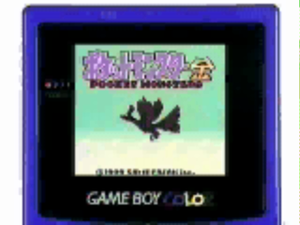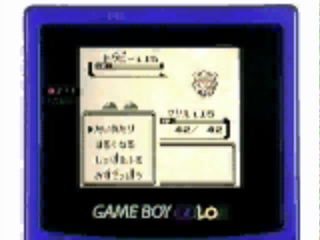Pokémon Gold and Silver beta
Pokémon Gold and Silver (Japanese: ポケットモンスター 金・銀 Pocket Monsters Gold and Silver) were the first Generation II games to be released — November 21, 1999 in Japan and October 11, 2000 in the US. However, they had been in development for at least 2 years before then.
1997: First Mention of Pocket Monsters 2 Gold & Silver
In 1997, Nintendo put the first details and screenshots of their next Pocket Monsters game online. It was initially named "Pocket Monsters 2 Gold & Silver", and was developed for GameBoy and Super GameBoy and was planned for release at the end of the same year.
One of the main points posted was the addition of a skateboard as a secondary transportation method besides the bicycle from the previous games. It was said that the skateboard would allow the player to go to unusual places. Also mentioned in the releases were the integrated RTC (Real Time Clock), additional evolutions for Red/Green/Blue Pokémon, breeding and Pokémon eggs, 100 new Pokémon boosting the total amount to 251, new technical and hidden machines, new attacks, and better in-battle graphics. The game's communication abilities were also improved, adding trading and fighting between each version and backwards compatibility with R/G/B.
First Media Release Pictures
The initial logo of Pokémon 2, differing significantly from the final design.
Four early release Pokémon. From left to right: Donfan (Donphan), Denryuu (Ampharos), Yadoking (Slowking) and Houou (Ho-oh).
First Screenshots
The color scheme was not as varied as the one provided by the Game Boy Color; this town was also ultimately either changed into Azalea Town (Perhaps with the Bellsprout Tower at left) or removed altogether.
Second known screenshot of the game. Again, this city was either completly scrapped or totally rebuild. Apparently, this build of the game uses a newer graphic set then the build of the first screenshot: The sign graphics are the same as in the final release. This is also the first time water is being displayed, as well as the first sighting of a NPC character.
Possibly an early screenshot of Goldenrod City or Celadon City; obviously a department store setting. The roofing on the rightmost building wound up making it to the final product.
This screenshot displays an area which, with little modification, made it into the game's final cut. Replace the water with trees and fences and open a path to the right, and a simplified version of Route 35 and the National Park's southern entrance materialize.
What is probably an early design for the Radio Tower is in the right-hand side of the screen.
1998: The 2 is dropped - Pokémon Gold & Silver
Pocket Monsters 2 was not released in the end of 1997 as originally stated. The expected release date was removed. The title was changed to Pocket Monsters Gold & Silver, dropping the 2.
1999 - New information
Following nearly a year without press releases, the Nintendo site was updated with new information on Pokémon Gold and Silver. It gave information on the revised release date (June 1999) and stated that it was to be compatable with the as-yet-unreleased Game Boy Color.
Artwork for Yadoking (Slowking), Marill, Kireihana (Bellossom) and Hoho (Hoothoot) were released.
- 1999 art yado1.gif
- 1999 art cara 1.gif
- 1999 art cara 2.gif
- 1999 art cara 3.gif
The first screenshots of the Pokémon G/S battle system, most prominently featuring several Pokémon in their new full color GBC graphics, were also released.
- 1999 shot p2.gif
Lv.42 Butterfree vs. Lv.38 Fushigibana (Venusaur)
- 1999 shot p3.gif
Player vs. Girl Scout Kanami
The battle screens are very similar to the final ones; however, the absence of gender notation is apparent. Pokémon gender was a previously announced, and the display of gender was likely added later as a convenience to players.
The attack stats window, which in the final version tells you the remaining and total PP of each attack and its type, was not fully completed at this point in development.
The new Pokédex is still missing a few features from the final edition; the Pokémon's number is not displayed beneath its picture and the footprint in the top right corner is missing, as are the three options near the bottom of the screen - location, cry and print.
- 1999 shot p5.gif
Route 30
- 1999 shot p6.gif
Route 32
- 1999 shot p7.gif
Route 45
- 1999 shot p8.gif
PokéMart
Graphically, the first three screenshots are similar to the final cut of the game. The white paths now have some darker patches applied to them, the water was for some reason reverted to its original design from R/G/B instead of the one that was already used in the 1997 shots (which is seemingly also the base of the final version's water) and the mountain edges in the third screenshot have a green grass tile in the corner instead of a brown mountain one.
The screen-capture of the PokéMart's interior is very different from the final version, looking more like colorized variants of R/G/B's mart graphics. Below are screenshots of the Red/Blue/Green shops in comparison to the Gold/Silver marts:
Two further screenshots of PokéMarts:
The first screenshot may be an early version Route 45 & 46, Blackthorn City to New Bark Town. Screenshot two clearly shows the National Park, slightly differing from the final product in both graphics and placement of items. For example, the decorative borders are larger and arranged differently, a trash can in the top left, normally next to two benches, is missing and the people around the scene are differently placed as well.
Present Day: Beta Leftovers
The Future: Whats Missing Here?
Well, the biggest gap in this reconstruction of G/S' development is the time from the dropping of the title's "2" in early 1998 to the overhaul of Nintendo's G/S site in early 1999 - a gap of about a year where quite an amount of development must have taken place. There surely exist some more screenshots and artworks from this timeframe, but sadly I'm unable to find them online. The best way to retrieve some of these "lost media" would probably be tracking down old Japanese gaming mags from this time, checking them for Pokémon G/S information and scanning the respective pages from them. But for the moment, the stuff here must be enough as getting such mags will take quite some time without some kind of contact in Japan.
References
- Pokémon GS Pre-Release Images
- Pokémon Gold & Silver - Development Reconstruction
- IGN Pocket
- Pkmn.co.uk Pokémon GS Beta Information
- Pkmn.co.uk Lost Pokémon!
- Pkmn.co.uk GS Beta Maps
- Pokefor.tk Pokémon GS Pre-Release (Wayback)
- Different archived versions of Nintendo of Japan's and IGN's GameBoy website.



